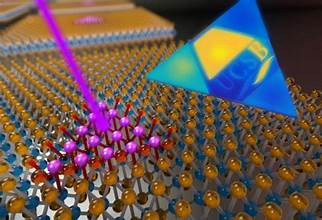The extraordinary at the atomic scale is being explored by nanotechnology.

The foundation of the ground-breaking science and engineering discipline of nanotechnology is the idea of manipulating matter at the nanoscale, or on the scale of billionths of a metre, or nanometers. The focus of this area of science is on comprehending and making use of the distinctive qualities and behaviours that result from structuring and modifying materials at such minute scales. Nanotechnology has the potential to completely transform a variety of sectors, from electronics and medicine to manufacturing and energy.
The word “nano” itself comes from the Greek word “nanos,” which means dwarf. In this context, nanotechnology enables researchers to work at the atomic and molecular level, revealing a world that defies our preconceived notions of matter and its behaviour. The physics that govern this scale occasionally deviates significantly from the physics that govern the macroscopic world.
Both “top-down” and “bottom-up” methods are used in nanotechnology. To create new structures and functionalities, materials are put together atom by atom or molecule by molecule in the bottom-up method. This approach is modelled after the way that complex systems are constructed naturally, from the smallest building blocks to the largest systems, using molecular interactions. The top-down strategy, on the other hand, entails reducing the size of already-existing larger structures and breaking them down into their component parts. In order to engineer nanoscale systems and devices, these methods are frequently used in synergy, combining the best of both worlds.
Utilising the Power of the Small: Applications of Nanotechnology
Numerous industries could be transformed by the numerous applications of nanotechnology. Electronics devices like computers, smartphones, and sensors can now be continuously improved thanks to the development of smaller, more effective components made possible by nanotechnology.
Electronics and computing: Electronics and computing have undergone a paradigm shift as a result of nanotechnology. Faster, more compact, and more effective devices have been made possible by nanoscale transistors and other components. The production of semiconductors with improved conductivity and lower energy consumption is made possible by the precise atomic-level manipulation of materials, which enhances processor performance and extends battery life. Additionally, nanoscale materials have the potential to revolutionise memory storage, opening the door for faster data retrieval and ultra-dense data storage devices.
- Medicine and healthcare: Innovative medical solutions are provided by nanotechnology. Targeted drug delivery techniques use nanoparticles to deliver drugs directly to diseased cells, reducing side effects and boosting therapeutic effectiveness. Imaging methods improved by nanoscale contrast agents offer unprecedented detail for disease monitoring and detection. The use of nanoscaffolds to direct cell growth and regeneration is advantageous for tissue engineering. Nanostructured materials are also essential in the development of biosensors for quick and precise diagnostics, from pathogen detection to blood glucose monitoring.
- Environmental concerns and energy: In the energy industry, nanotechnology is crucial. Through improved battery and supercapacitor technologies, nanomaterials improve energy storage, enabling longer-lasting and quicker-charging devices. Solar cells benefit from nanoscale structures that improve light absorption and electron movement, resulting in more effective energy conversion. With the help of nanoparticles that neutralise toxins and contaminants, nanotechnology is also used to purify water, filter air, and control pollution, making the world a safer and cleaner place.
Pioneering a Revolutionary Future: The Importance of Nanotechnology
The impact of nanotechnology on medicine is at the forefront. Targeted drug delivery is made possible by the ability to manipulate matter at the nanoscale, improving treatment effectiveness while reducing side effects. Early disease detection and personalised medicine are now possible thanks to the advancements in diagnostics brought about by nanoparticles and nanodevices. Medical imaging has been improved by nanoscale-precision imaging techniques, which make it easier to see the complex internal structures of the human body.
- Energy Efficiency and Sustainability: Nanotechnology is an important ally in the search for sustainable energy sources. More energy can be converted from sunlight thanks to nanomaterials’ improvement of solar cell efficiency. Innovations at the nanoscale are advantageous for energy storage technologies, improving battery performance and energy storage capacity. Optimising energy consumption across industries, nanotechnology helps to develop strong, lightweight materials.
- Economic Growth and Competitiveness: Nanotechnology investments help countries position themselves as innovator leaders and promote economic growth and international competitiveness. Jobs in various sectors become available as research and development grow. Industries based on nanotechnology have a cascading effect that propels innovation across many industries and boosts economic resilience.
The frontiers of innovation for nanotechnology and artificial intelligence are converging.
Two of the most revolutionary technological paradigms of the twenty-first century are nanotechnology and artificial intelligence (AI). Despite appearing to be separate fields, these ones are increasingly coming together to maximise their potential and produce ground-breaking solutions for a variety of industries. AI and nanotechnology, which simulate human intelligence in machines and involve manipulating matter at the nanoscale, are combining to create previously unimaginable powers that were previously only available in science fiction.
- improving nanofabrication and accuracy: The process of designing and producing nanoscale structures has been completely transformed by the integration of AI with nanotechnology. In order to create new materials with specialised properties, AI algorithms are used to simulate and optimise the behaviour of nanomaterials. Using machine learning algorithms, complex structures made of nanoparticles can be assembled with greater accuracy and efficiency. The exploration of a broad design space is made easier by this convergence, hastening the discovery of novel nanomaterials with particular functions.
- Innovations in diagnostic and therapeutic procedures in medicine: The combination of AI and nanotechnology holds enormous promise for the medical industry. Drugs can be delivered precisely where they are needed thanks to nanoscale devices that can be designed to target specific cells or tissues. AI-powered algorithms examine intricate medical data, including genomic details and medical images, to personalise treatment plans and forecast the course of diseases. AI-enabled nanosensors can monitor biomarkers in real-time, providing early disease detection and facilitating prompt interventions.
- Systems controlled by AI and nanorobotics: The concept of nanorobotics—in which AI-powered nanoscale robots could carry out tasks at the atomic or molecular level—is born from the convergence of nanotechnology and AI. These nanobots were able to move through biological systems, helping with tasks like drug delivery, tissue repair, and even cellular-level surgery. These nanorobots are moved and interacted with by AI algorithms, ensuring accurate and effective task execution in challenging environments.
- Challenges and ethical considerations are as follows:Challenges and ethical issues are also raised by the fusion of nanotechnology and AI. Nanomaterials’ potential effects on the environment and human health raise safety issues that need to be addressed. Furthermore, the ethical ramifications of AI-driven nanorobots interacting with biological systems raise concerns about control, autonomy, and unintended consequences.
Conclusion
Collaboration between numerous scientific fields, including physics, chemistry, biology, materials science, and engineering, is necessary for the development of nanotechnology. To address the various difficulties and chances presented by working at the nanoscale, a multidisciplinary approach is necessary. Targeted drug delivery, cutting-edge imaging methods, and cutting-edge diagnostic tools have all been made possible in medicine thanks to nanotechnology.



